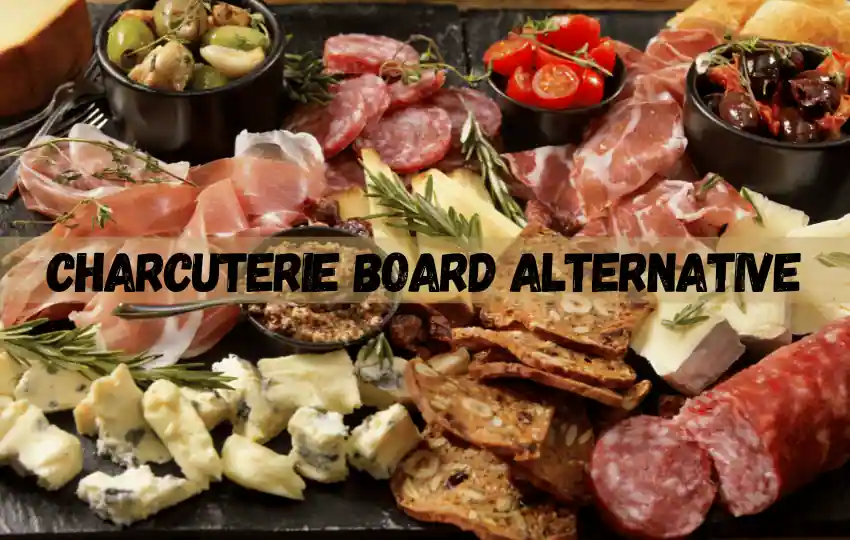The world would be a more suitable place if we all had a charcuterie board on our kitchen table every day. They are perfect for a party, dinner for two, or even a snack.
However, occasionally you want to mix things up and try something different. That’s where charcuterie board alternatives come in handy.
In this post, we will provide you with 18 quick charcuterie board alternatives that are just as delicious and easy to put together.
In short, "What can I use if I don't have a charcuterie board?" Crudités Platter, DIY Nachos, Fruit Plate, Baked Pita and Dips, Bagel Breakfast Board, Dessert Board, Sushi Board, Popcorn and Candy, Sandwich Slice Board, Taco Board, Mediterranean Board, Breakfast Board, Mexican Board and many more.
What is a charcuterie board?
Charcuterie boards are composed of a selection of cured and smoked meats, cheeses, nuts, olives, pickles, crackers or bread.
Some boards also include fruit, such as grapes or apples, to add texture and flavor.
Depending on the preference of the person assembling the Board, they can be arranged in an aesthetically pleasing way that will surely impress any guest.
Assembling a charcuterie board does not require much skill, just an eye for presentation and flavor combination.
It can be as effortless or elaborate as desired; there are an endless number of potential combinations that you can try to make your own unique creation!
Popular items to put on charcuterie boards include
• Salami
• Prosciutto
• Cheeses (such as brie, cheddar, and blue cheese)
• Meats (such as smoked salmon)
• Olives
• Pickles
• Crackers or Bread
• Mustards and other condiments
• Nuts and Fruits
Uses of a charcuterie board
A charcuterie board is an awesome way to enjoy a variety of cured meats, cheeses, nuts and other snacks. It’s perfect for entertaining guests or snacking on a lazy day.
Charcuterie boards can easily be customized to feature the flavors that you or your guests prefer.
Charcuterie boards make excellent appetizers. Start by arranging an array of meats, cheeses and accompaniments on a board or large plate.
Make sure to include different types of cured meat, such as prosciutto, salami, pepperoni, chorizo and soppressata.
Add slices of mild or sharp cheese like cheddar, brie or gouda. Include some nuts and dried fruits like almonds, walnuts, dates and figs for a crunchy texture.
Place pickled vegetables like olives, cornichons or artichokes on the Board as well.
To add a little sweetness to your charcuterie board, include crackers, jams and honeycomb. Add savory items such as dips and spreads like hummus, tapenade or pesto to accompany the meats and cheeses.
And don’t forget about garnishes like fresh herbs or edible flowers to give your Board an elegant look.
With all these delicious options, everyone can create their own unique flavor combination! Charcuterie boards are a superb way to enjoy good food with friends and family.
Put together your own Board today and enjoy the taste of something special.
Note: Make sure to include a variety of cured meats, cheeses, accompaniments like jams, crackers and pickled vegetables, nuts and dried fruits, savory items like hummus or pesto, as well as fresh herbs or edible flowers for garnish.
Best charcuterie board alternatives
1. Crudités Platter
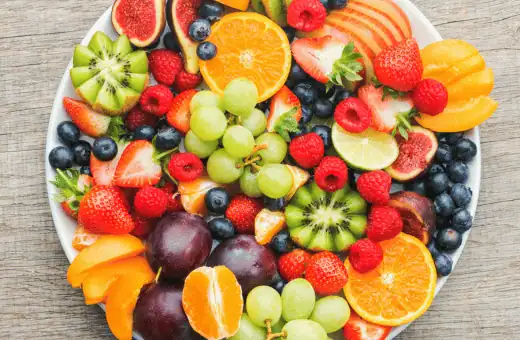
Crudités Platter is a delicious substitute for a charcuterie board.
Cut up your favorite vegetables, such as carrots, peppers, cucumbers, and celery, and arrange them on a colorful platter.
Then add a hummus or ranch dip for an appetizing touch.
2. DIY Nachos
Arrange tortilla chips on your Board, pour melted cheese on top, and add jalapenos, guacamole and salsa for a flavorful twist on the traditional charcuterie board.
3. Fruit Plate
This is also a very tasty and delicious alternative to charcuterie board.
Slice your favorite fruits, such as watermelon, pineapple, strawberries, and grapes and arrange them on a colorful platter.
You can also add a side of whipped cream, or Nutella is delightful.
4. Baked Pita and Dips
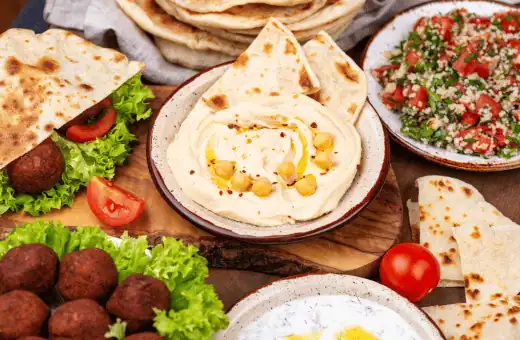
Arrange pita chips and dips like tzatziki and hummus on a board. After that, top it off with a few olives and cherry tomatoes for a Mediterranean flair.
5. Bagel Breakfast Board
Layer bagels with cream cheese smoked salmon, capers, eggs, and chives for a delicious breakfast board. This option makes breakfast feel like a fancy brunch.
6. Dessert Board
Use cookies, chocolates, cakes, and sweet toppings to create a dessert board. Anything goes with this one.
Use a wooden board or tray and add bowls or jars for dips like chocolate and caramel.
7. Sushi Board
For the sushi lovers out there, create a sushi board with sushi rolls, wasabi, ginger, soy sauce, and chopsticks.
You can also add edamame, seaweed salad, and tempura for some variety. This one is sure to impress you at your next gathering.
8. Popcorn and Candy
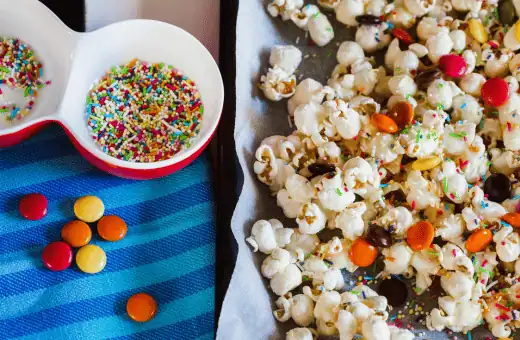
For a family movie night, arrange popcorn and different types of candy on a board for everyone to share. Perfect for a cozy night at home.
9. Sandwich Slice Board
This is my all-time favorite option. Slice pre-made sandwiches filled with ham, turkey, cheese, lettuce, tomatoes, and avocado for a quick and easy lunch spread.
10. Taco Board
For a fun twist on the charcuterie board, you can arrange taco ingredients like tortillas, cheese, seasoned meats, and lettuce on a board. Let everyone make their own tacos.
11. Mediterranean Board
This is a fantastic option for a healthy snack or appetizer.
Create a Mediterranean-inspired board with hummus, pita, olives, feta cheese, cucumber slices, and cherry tomatoes.
12. Breakfast Board
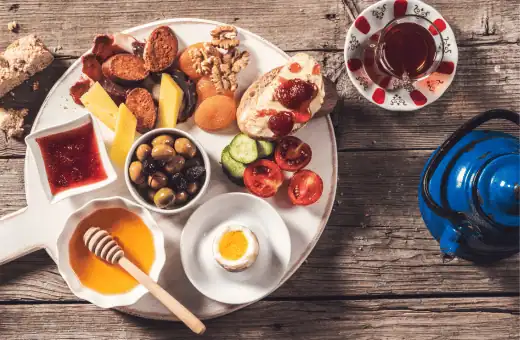
Start your day off with a breakfast board filled with bagels, cream cheese, yogurt, granola, fresh fruit, and hard-boiled eggs.
This is a fantastic option for a weekend brunch or a quick breakfast on the go.
13. Mexican Board
Spice things up with a Mexican-inspired board featuring chips, salsa, guacamole, shredded cheese, sour cream, and taco meat.
You can also add veggies like peppers and onions for a healthier option.
14. Grilled Cheese Board
Who doesn’t love grilled cheese? I know you also like it very much.
Create a grilled cheese board with an assortment of bread, cheese, meats, and toppings like tomatoes and bacon.
Do not forget to serve with a side of tomato soup to impress your guests.
15. Antipasto Board
Similar to a charcuterie board, an antipasto board includes cured meats, cheeses, olives, and other Italian snacks like bruschetta.
This is perfect for a pre-dinner snack or appetizer.
16. Hot Chocolate Board
Heat up on a chilly night with a hot chocolate board. Add hot cocoa mix, marshmallows, whipped cream, sprinkles, and candy canes to your Board.
You can also add a variety of mugs and hot water for guests to make their own hot chocolate.
17. Fondue Board
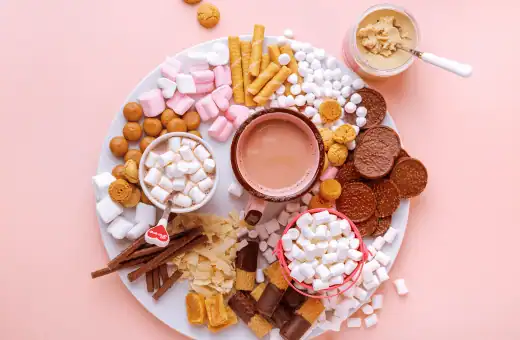
You can make a fondue board with a variety of dipping items like bread, veggies, and fruit. You can also add a bowl of melted cheese or chocolate for dipping and enjoy!
18. DIY Sandwich Board
Last but not the list is DIY Sandwich Board.Create a DIY sandwich board with sliced meats, cheeses, veggies, and condiments, then let your guests make their own sandwiches.
This is ideal for a casual lunch or dinner party.
Discover more: Quick Substitutes for biscoff spread
5 Best charcuterie board ideas
1. Classic Charcuterie Board
This traditional Board is perfect for those who appreciate the simple elegance of cured meats and artisanal cheeses.
Contain a variety of cured meats such as prosciutto, salami, and coppa. Pair them with a selection of hard and soft cheeses like aged cheddar, brie, gouda, and blue cheese.
Add crusty bread or crackers, olives, cornichons, and a variety of nuts for added texture and flavor.
2. Mediterranean Charcuterie Board
Transport your tongue to the Mediterranean with this flavorful Board. Incorporate cured meats like chorizo and soppressata alongside cheeses such as feta, manchego, and halloumi.
Enhance the Board with fresh and dried fruits like figs, grapes, and apricots. Complement these flavors with olives, hummus, tzatziki, marinated artichokes, and pita bread.
3. Vegetarian Charcuterie Board
A meatless board that is both visually appealing and satisfying. Choose a variety of cheeses like goat cheese, camembert, and smoked gouda.
Add an assortment of vegetables, such as cherry tomatoes, cucumber slices, and bell pepper strips. Include fruits like grapes, apples, and pears for a touch of sweetness.
Incorporate marinated mushrooms, stuffed peppers, and roasted red peppers for extra flavor. Serve with a variety of crackers and breadsticks.
4. Seafood Charcuterie Board
A unique spin on the traditional charcuterie board, perfect for seafood lovers. Then include smoked salmon, shrimp cocktail, and smoked oysters or mussels.
Pair with soft cheeses like cream cheese, Boursin, and herbed goat cheese.
Add accompaniments like capers, pickles, and slices of lemon. Serve with a variety of crackers, crostini, and seaweed snacks for a nautical touch.
5. Dessert Charcuterie Board
End your gathering on a sweet note with this dessert-inspired Board. Choose a variety of cheeses that pair well with sweets, such as brie, mascarpone, and blue cheese.
You can include a selection of chocolates, candied nuts, and dried fruits like apricots, dates, and figs.
Add bite-sized desserts such as macarons, mini tarts, and chocolate truffles. Serve with dessert wines or a rich coffee for an indulgent treat.
5 Best Cheese and crackers alternatives in Charcuterie Board
1. Veggie Sticks and Dips
Swap out the traditional cheese and crackers for an assortment of fresh, crunchy veggie sticks like carrots, celery, cucumber, bell peppers, and radishes.
Pair them with a variety of dips, such as hummus, tzatziki, baba ganoush, or a creamy spinach dip. This healthy alternative adds color and texture to your charcuterie board.
2. Rice Cakes and Nut Butter
For a gluten-free and lighter option, you can use rice cakes or rice crackers as a base. Top them with a variety of nut butter, like almond, peanut, or cashew butter.
Also can add a touch of sweetness with a drizzle of honey, a sprinkle of cinnamon, or a few dark chocolate chips. This combination offers a unique texture and satisfying crunch.
3. Fruit and Yogurt
This offers a sweet and tangy alternative by pairing fresh or dried fruits with yogurt-based spreads or dips.
Select fruits like apple slices, grapes, strawberries, and apricots. Serve them alongside flavored Greek yogurt, whipped cream cheese with honey, or a fruit compote.
This pairing adds a refreshing and nutritious element to your charcuterie board.
4. Polenta Bites and Toppings
Prepare small rounds or squares of cooked polenta, and top them with a variety of flavorful toppings like sautéed mushrooms, roasted tomatoes, pesto, or olive tapenade.
This creative alternative to cheese and crackers adds a delicious and unique touch to your charcuterie board while catering to gluten-free guests.
5. Sliced Cucumbers and Spreads
This low-carb, gluten-free option is perfect for those looking for a healthier twist on the traditional charcuterie board.
Use sliced cucumber rounds as a light and refreshing alternative to crackers. Top them with a variety of spreads, such as herbed cream cheese, goat cheese with herbs, or a savory tapenade.
Next, garnish with a sprinkle of smoked paprika or fresh dill for added flavor.
How to make an inexpensive charcuterie board?
Creating an inexpensive charcuterie board doesn’t mean you have to sacrifice quality or taste. Follow these tips to build an affordable yet delicious spread:
1. Shop wisely: Look for sales, discounts, and deals at your local grocery store. Check out the deli counter for budget-friendly options, and consider buying in bulk for items like nuts, olives, and dried fruits.
2. Prioritize affordable ingredients: Focus on less expensive meats and cheeses, such as salami, pepperoni, or cheddar. You can also include budget-friendly spreads like hummus, cream cheese, or salsa.
3. Opt for seasonal and local produce: Select fresh fruits and vegetables that are in season and locally sourced to save money. Seasonal produce is often more affordable and tastes better.
4. DIY accompaniments: Make your own accompaniments like pickles, marinated vegetables, or flavored popcorn to save money and add a personal touch to your Board.
5. Be mindful of portions: Avoid overloading your Board with too many items, and instead focus on smaller, thoughtfully arranged portions. It will help save money and prevent waste.
Here’s an example of an inexpensive charcuterie board
1. Meats: Salami, pepperoni, or sliced deli ham.
2. Cheeses: Cheddar, mozzarella, or pepper jack.
3. Fruits and vegetables: Seasonal fruits (such as grapes, apple slices, or berries) and vegetables (like cucumber, carrot sticks, or cherry tomatoes).
4. Accompaniments: Olives, pickles, or homemade marinated vegetables.
5. Dips and spreads: Hummus, salsa, or cream cheese.
6. Bread and crackers: Inexpensive crackers, baguette slices, or pretzels.
Arrange these items on a large cutting board, platter, or tray, and enjoy a budget-friendly charcuterie experience that doesn’t skimp on flavor.
Conclusion on charcuterie board alternative
If you want to show off your hosting and presentation skills without slaving away assembling a charcuterie board, these 18 quick alternatives are perfect.
Whether you are arranging an intimate gathering or a family movie night, these boards are sure to be a hit. These ideas give you more options to choose from.
Have fun and enjoy playing with the boards’ arrangements and different twists to show off your creativity and skills. Happy snacking!
FAQs on charcuterie board alternative
Q1. What is similar to a charcuterie board?
Charcuterie boards are related to cheese boards and antipasti platters. Cheese boards offer a variety of cheeses, usually in addition to crackers or bread, along with fruits and nuts. Antipasti platters offer a variety of cured meats such as salami and prosciutto, olives, vegetables, and cheeses.
Charcuterie boards generally contain the same items but may also include items like pates, terrines, pickles, mustards, and other condiments. All three types of Board provide an array of flavors that can be shared among friends or enjoyed alone. They make great appetizers for parties or perfect snacks for just about any occasion!
Q2. What works well as a charcuterie board?
Charcuterie boards are a famous way to serve a variety of cured meats, cheeses, fruits, nuts, crackers, and other snacks at parties or gatherings. Here are some items that work well on a charcuterie board:
1. Cured meats: Salami, prosciutto, chorizo, and pepperoni are popular choices for a charcuterie board. You can slice them thin and roll them up for easy serving.
2. Cheeses: Choose a variety of soft, hard, and aged cheeses such as brie, cheddar, gouda, blue cheese, and goat cheese. Slice them into bite-sized pieces and arrange them on the Board.
3. Fruits: Grapes, strawberries, figs, and sliced apples or pears are a great way to add some sweetness to the Board. They also provide a nice difference to the savory meats and cheeses.
4. Nuts: Almonds, pistachios, and walnuts are popular choices. Also can add some dried fruits like cranberries or apricots.
5. Crackers and Bread: Choose a variety of crackers and bread, such as baguette slices, crostini, or whole-grain crackers, to serve alongside the meats and cheeses.
6. Spreads and dips: You can add some mustard, jam, honey, or hummus to the Board to add some extra flavor and texture.
Remember to arrange everything on the Board in an aesthetically pleasing way, and make sure to have plenty of utensils and plates available for your guests. Enjoy!
Q3. Can you use a regular cutting board as a charcuterie board?
Yes, you can definitely use a regular cutting board as a charcuterie board. Here are some leads on how to utilize a regular cutting board as a charcuterie board:
1. Clean the cutting board: Make sure the cutting board is clean and free of any leftover food or odors. Rinse it with warm soapy water and let it dry completely.
2. Choose the right size: Choose a cutting board that is large enough to hold all the items you want to include on your charcuterie board.
3. Arrange the items: Start by placing the larger items on the Board first, such as cheese wedges, cured meats, or bowls of dips. Then, fill in the vacant spaces with smaller items like crackers, sliced fruit, or nuts. Arrange the items in a way that looks visually appealing and inviting.
4. Use ramekins or small bowls: If you want to include dips, jams, or spreads on your charcuterie board, use small ramekins or bowls to keep them contained and stop them from spreading onto other items.
5. Label the items: To make it easier for your guests to identify the items on the charcuterie board, you can label them using small chalkboard signs or place cards.
6. Serve with utensils: Make sure to provide your guests with the necessary utensils, such as cheese knives, spreaders, and tongs, to serve themselves.
By following these easy suggestions, you can easily transform a regular cutting board into a beautiful and functional charcuterie board for your next party or gathering.
Q4. Do charcuterie boards have to be wooden?
No, charcuterie boards do not have to be wooden. While wooden boards are a popular choice due to their natural and rustic appearance, there are several other materials you can use for your charcuterie board. The most important aspect is that the surface is food-safe and easy to clean. Some alternative materials for charcuterie boards include:
1. Marble or granite: These elegant and sophisticated surfaces are ideal for serving cold items, as they help maintain a cool temperature. Marble and granite boards are also easy to clean and provide a beautiful backdrop for your charcuterie arrangement.
2. Slate: Slate boards offer a unique, modern appearance with a dark, smooth surface that contrasts beautifully with the vibrant colors of the charcuterie ingredients. You can also write directly on the slate with chalk to label your items, adding a personal touch to your presentation.
3. Ceramic or porcelain: These materials create a refined and polished look for your charcuterie board. Ceramic or porcelain plates and platters come in various shapes, sizes, and colors, allowing you to find one that suits your style and needs.
4. Glass: A glass platter or Board can provide a sleek and contemporary look. Clear glass showcases the ingredients, while colored or patterned glass can add visual interest to your charcuterie presentation.
5. Acrylic or melamine: These lightweight, durable, and affordable materials are perfect for outdoor gatherings or casual get-togethers. Acrylic and melamine boards come in a variety of colors and designs, making it easy to find one that fits your theme.
When choosing a charcuterie board, consider your personal style, the occasion, and your budget to select the perfect material for your needs.
Q5. What is charcuterie without meat called?
Charcuterie is traditionally a French term that refers to the art of preparing and preserving meat products such as sausages, cured meats, pâtés, and terrines. Therefore, without meat, it would not be considered charcuterie.
However, there are vegetarian and vegan options for charcuterie that are made with plant-based ingredients such as nuts, seeds, fruits, and vegetables. These can be referred to as vegan charcuterie or plant-based charcuterie.
Q6. What’s the difference between a charcuterie board and a cutting Board?
A charcuterie board and a cutting board serve different purposes in the kitchen.
A cutting board is a flat, often rectangular Board used for cutting and preparing food. It can be created from various materials such as wood, plastic, or bamboo and is designed to protect countertops and knives from damage.
On the other hand, a charcuterie board is a platter, or Board used to present an assortment of meats, cheeses, crackers, fruits, and other small bites. It is typically made of wood, slate, or marble and is designed to be visually appealing and functional for serving a variety of snacks.
While both a cutting board and a charcuterie board may be made of wood, they serve different functions. A cutting board is primarily used for food preparation and should be cleaned thoroughly after each use, while a charcuterie board is used for serving and should be cleaned and maintained for presentation purposes.

